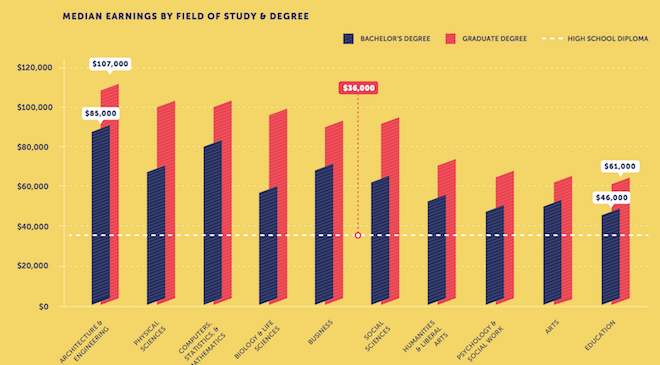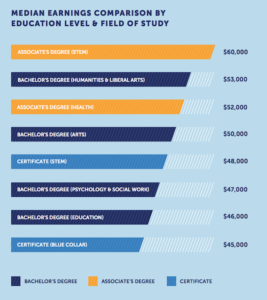
NYU Stern. Ethan Baron photo
College has been associated with economic mobility throughout American history. But as traditional factory and blue collar jobs continue to be phased out of the American economy, the importance of some sort of higher education continues to increase for Americans hoping to see upward economic movement. Research published earlier this month from Georgetown University’s Center on Education and the Workforce reveals that a bachelors degree is worth double the income of those holding just a high school diploma. According to their research, which examined U.S. Census data of American workers from age 25 to 59 between 2009 and 2016, college graduates earn a median annual income of $62,000 — exactly double the median of $36,000 for high school diploma earners.
“In the old industrial economy before the 1980s, high school was enough to provide middle class earnings for most Americans: two-thirds of jobs required workers with only a high school education or less,” the authors of the report wrote in the intro. “Now, except for about 20 percent of males who can still make it in the blue-collar sector, the high school economy is gone and it is not coming back. Two-thirds of jobs now require workers with at least some college.”
The data is part of the Five Rules of the College and Career Game report published by Anthony Carnevale and Ban Cheah. Carnevale is a research professor and director of the Center on Education and the Workforce and Cheah is a research professor and senior economist of the Center. The first rule? “Education level still matters, and generally more more education is better,” the report says. Those that have earned graduate degrees enjoy the highest median income of all groups at $80,000. But even beginning college and not necessarily completing puts Americans at an economic advantage over not going to college at all. Those with “some college” earn a median salary of $42,000 and if an associates degree is earned, the number climbs to $47,000.

Median earnings by education level. Graphic from Five Rules of the College and Career Game report from Georgetown University
Of course, the major in which college students choose will have a direct impact on earnings potential. Those majoring in architecture and engineering earn a median of $85,000 — more than any other bachelors degree. At the other end is education, which has a median income of $39,000. Business majors enjoy one of the higher salary ranges, earning around $67,000 for a median annual income. The spread in earning potential is one factor the authors believe is contributing to a growing amount of “buyer’s remorse” among college graduates.
“The growing buyer’s remorse among former students has made times even more uncertain,” Carnevale and Cheah write. “The majority of Americans (51%) would change their degree type, institution, or major if they could do it again, according to the results of a 2017 Gallup Poll. These regrets were influenced by a number of factors, but one was lack of information about degrees and the careers they could lead to.”

Median earnings by field of study. Graphic from the Five Rules of the College and Career Game report published by Georgetown University
The authors use business majors as an example in the potential range among salaries. While the median annual salary for biz majors is $67,000, a quarter (25%) earn $100,000 or more. At the lower end, some 25% of biz majors earn about the same among as the median salary for education majors as well as psychology and social work majors.

Median salary ranges from high to low. Graphic from the Five Rules of the College and Career Game report published by Georgetown University
It’s still possible that an associates degree or certificate can produce more income than a bachelors degree, but again, it depends on the major. Those earning an associates degree in STEM-related fields (science, technology, engineering, and mathematics) earn a median income of $60,000, which is greater than four different fields of majors. Earning a certificate in STEM-related fields will earn a median of $48,000 — higher than two different fields of study. Even a certificate in “blue collar” fields will earn a median income of $45,000, which is just $1,000 less than education majors.

What associates degrees can earn. Graphic from the Five Rules of the College and Career Game report published by Georgetown University
This data along with the massively growing market of higher education convolutes things for high school students and their parents, the researchers say. “The variety of postsecondary programs and credentials today, however, has become a Tower of Babel, a system too vast for prospective students to comprehend and evaluate by institutional reputation alone,” Carnevale and Cheah write. According to the introduction of the report, postsecondary programs available turbocharged from 410 in 1985 to 2,260 by 2010. “Since 1950, the number of colleges and universities has more than doubled and the number of college students has increased tenfold,” the report says. And the number of “distinct occupations” has tripled to more than 800.
“Because postsecondary education and training have become the most well-traveled pathways to middle class earnings, both students and the educators who serve them need to learn new rules of the college and career game,” the report concludes. “Students need to shop around for college because higher education is a student’s first major investment in the transition from dependent adolescent to independent adult. Students deserve to know what they are paying for.”
DON’T MISS: THE BEST COMPANIES FOR RECENT GRADS or WHAT BUSINESS MAJORS MAKE











Questions about this article? Email us or leave a comment below.